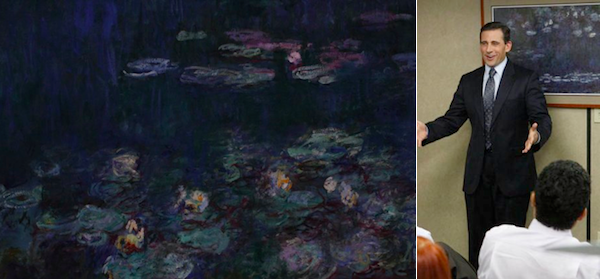Random
Late work

One wonders if the staff of Dunder Mifflin ever saw the late Monet waterlilies painting, a print at least, framed in the conference room as a kind of covert bourgeois window through which one might mentally escape to softer times, whose chubby mascot was a man slowly taken by cataracts, whose artistic vision was no doubt clearer than his literal one. French impressionist (and, to a degree, Pop Art and Abstract Expressionist) prints are mainly used in corporate settings to placate the employee, condescendingly, as if all they needed to be happy was something pretty to stare at, when in fact it only implicates the dissonance between surrendered office life and the more vigorous ideals of artistic inquiry. I’ve always found the late Monet print an odd, yet provocative, choice. Perhaps the set designers wanted something deep behind the shallowness of Michael Scott. As The Office plays out its final season, we may be left with some more inadvertent metaphors: the casting politics of who would play the boss, and the legacy of an unstable company, who in a realist market would have been eaten alive by more faceless competitors Office Depot and Office Max; the sweet courtship and eventual nuptials of Jim and Pam, whose subsequent boredom of each other seemed to ooze from the actors without acting; the rogue zen of Stanley Hudson, who solved 10,000 crossword puzzles in what were likely out-of-body experiences; the increasingly comical scenarios less probable, obsolete after the novelty of the ironic “fourth wall nod” wore thin. Most compelling were the accurate personnel departments (e.g. Accounting, Office Relations, Sales, Human Resources, Executive, Warehouse, Production) ascribed to each character, whose demeanor and actions held consistent with them. Such vocational intricacy had, in the past with other shows, been simply consolidated as an abstract “job” to which someone went when they weren’t on the main stage, that is, home. The Office took the family away from home, into their own personal world of laughter and resent. Monet, the more successful of the French impressionists, built Giverny garden for the sole purpose of having a final chronic subject to paint until his death; he painted around two-hundred-and-fifty waterlilies, whose muddled canvases, thick and opaque, wore the transparent mask of a lake’s surface barely there. At its best, art is the profound realization of the invisible. Imagine a half-blind man — who famously declined ophthalmological help in aid of his abstractions — squeezing out more and more purple like an inside bruise finally surfacing, each work darker and darker, as if to trace the slow yet unwavering arc of an hourhand as it approaches night.

Beautiful.
that show doesn’t deserve writing this good